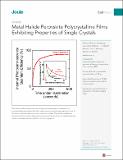Notice
This is not the latest version of this item. The latest version can be found at:https://dspace.mit.edu/handle/1721.1/133007.2
Metal Halide Perovskite Polycrystalline Films Exhibiting Properties of Single Crystals
| dc.contributor.author | Brenes, Roberto | |
| dc.contributor.author | Guo, Dengyang | |
| dc.contributor.author | Osherov-Beizerov, Anna | |
| dc.contributor.author | Noel, Nakita K. | |
| dc.contributor.author | Eames, Christopher | |
| dc.contributor.author | Hutter, Eline M. | |
| dc.contributor.author | Pathak, Sandeep K. | |
| dc.contributor.author | Niroui, Farnaz | |
| dc.contributor.author | Friend, Richard H. | |
| dc.contributor.author | Islam, M. Saiful | |
| dc.contributor.author | Snaith, Henry J. | |
| dc.contributor.author | Bulović, Vladimir | |
| dc.contributor.author | Savenije, Tom J. | |
| dc.contributor.author | Stranks, Samuel David | |
| dc.date.accessioned | 2021-10-15T19:27:05Z | |
| dc.date.available | 2021-10-15T19:27:05Z | |
| dc.date.issued | 2017-09 | |
| dc.identifier.issn | 2542-4351 | |
| dc.identifier.uri | https://hdl.handle.net/1721.1/133007 | |
| dc.description.abstract | © 2017 The Authors Metal halide perovskites are generating enormous excitement for use in solar cells and light-emission applications, but devices still show substantial non-radiative losses. Here, we show that by combining light and atmospheric treatments, we can increase the internal luminescence quantum efficiencies of polycrystalline perovskite films from 1% to 89%, with carrier lifetimes of 32 μs and diffusion lengths of 77 μm, comparable with perovskite single crystals. Remarkably, the surface recombination velocity of holes in the treated films is 0.4 cm/s, approaching the values for fully passivated crystalline silicon, which has the lowest values for any semiconductor to date. The enhancements translate to solar cell power-conversion efficiencies of 19.2%, with a near-instant rise to stabilized power output, consistent with suppression of ion migration. We propose a mechanism in which light creates superoxide species from oxygen that remove shallow surface states. The work reveals an industrially scalable post-treatment capable of producing state-of-the-art semiconducting films. Metal halide perovskites are exciting materials for low-cost optoelectronic devices such as solar cells and LEDs. In order to reach the theoretical efficiency limits for both applications, any parasitic non-radiative charge-carrier recombination losses, such as those mediated by carrier trapping, must be eliminated. At present, perovskite materials still suffer from substantial non-radiative decay, particularly under solar illumination conditions, and are therefore yet to reach their full potential. Perovskite single crystals have very low trap concentrations but their controlled growth into devices does not lend themselves to the advantages offered by solution-processing thin films such as roll-to-roll depositions. Here, we demonstrate the use of light and atmospheric treatments on polycrystalline perovskite films, resulting in minimal non-radiative losses and properties approaching those of perovskite single crystals and even the best crystalline semiconductors reported to date. The authors demonstrate the use of light and atmospheric treatments on polycrystalline perovskite thin films, resulting in properties approaching those of the best crystalline semiconductors reported to date. The results translate to exceptional photovoltaic device performances with rapid rises to stabilized power output consistent with an inhibition of ionic migration. | en_US |
| dc.description.sponsorship | NSF (Grant 1605406) | en_US |
| dc.language.iso | en | |
| dc.publisher | Elsevier BV | en_US |
| dc.relation.isversionof | http://dx.doi.org/10.1016/j.joule.2017.08.006 | en_US |
| dc.rights | Creative Commons Attribution 4.0 International license | en_US |
| dc.rights.uri | https://creativecommons.org/licenses/by/4.0/ | en_US |
| dc.source | Elsevier | en_US |
| dc.title | Metal Halide Perovskite Polycrystalline Films Exhibiting Properties of Single Crystals | en_US |
| dc.type | Article | en_US |
| dc.identifier.citation | Brenes, Roberto, Guo, Dengyang, Osherov-Beizerov, Anna, Noel, Nakita K., Eames, Christopher et al. 2017. "Metal Halide Perovskite Polycrystalline Films Exhibiting Properties of Single Crystals." Joule, 1 (1). | |
| dc.contributor.department | Massachusetts Institute of Technology. Research Laboratory of Electronics | en_US |
| dc.relation.journal | Joule | en_US |
| dc.eprint.version | Final published version | en_US |
| dc.type.uri | http://purl.org/eprint/type/JournalArticle | en_US |
| eprint.status | http://purl.org/eprint/status/PeerReviewed | en_US |
| dc.date.updated | 2019-05-10T18:02:53Z | |
| dspace.orderedauthors | Brenes, R; Guo, D; Osherov, A; Noel, NK; Eames, C; Hutter, EM; Pathak, SK; Niroui, F; Friend, RH; Islam, MS; Snaith, HJ; Bulović, V; Savenije, TJ; Stranks, SD | en_US |
| dspace.date.submission | 2019-05-10T18:02:54Z | |
| mit.journal.volume | 1 | en_US |
| mit.journal.issue | 1 | en_US |
| mit.metadata.status | Publication Information Needed | en_US |
| mit.metadata.status | Authority Work and Publication Information Needed |

